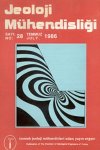
ABSTRACT: Geochemical analyses of iron deposits in the Divriği region ha.ve been performed on 160 samples for 10 major and. 31 trace elements, and correlation analyses between 24 elements and the Interpretation of these results are given, Two types of ores werq indicated.: The first type has a geochemical affinity to ultrabasic rocks with high, average element contens of Cr,, Co and in some cases Ni and MgO. The second type of ore is a sedimentary type with a different geochemical character., e.g. high Ba. content, The tectonically emplaced iron ores showing ultrabasic element affinity are suggested to be tectonically reworked from ophiolite hosted basic to- ultrabasic rocks.
ABSTRACT : In this study, geomechanical properties of the soil units which forms the Mgnitic series in Erzurum- Horasan-Ali çeyrek area are investigated, furthermore expected soil behavior during mining excavations and the applicability of some mining methods are discussed from the geotechnical point of veiw. From the geotechnical point of view» days in the area investigated, show relatively durable, highly plastic.» nonsensitive and montmoriUonitic character. On the other hand,,, sands generally form loose» uniform and weak soils however` show medium to veak properties. Studies carried out on. clay soils indicate some positive behaviors such as soundness, relatively long term, unsupported stand-up time with the exception, of medium-high swelling potential. In, loose sand horizons, especially below the groundwater level» -ravelling» running` and short term unsupported stand-up time behaviors should be expected. Therefore, the occurance of some limitations ought to be considered for the applicability of underground mining methods, in. the area. In the case of applying open pit method,» loose sand, horizons are` considered as one of the most important factors controlling the stability. Thus, final pit slopes should be designed with angles flatter than. 45 degrees. In addition » because of the long` duration of mining aperations and determined, geomechanical properties of cohesive soils in the area, long` term stability would be most critical stability condition and should be öncluded in the investiga- - tions of slope stability.
ABSTRACT: The existan.ce of suhphide ore deposits of Cyprus has been, known since the ancient times.. These ore deposits are placed within the pillow lavas which make the uppermost sequence of the Upper Cretaceous Troodos Massif... various giophysical methods have been used by many research, warkers to investigate the general structure of the region, and to locate ore bodies. jSpcept the electrical methods, they haven`t been successful to locate sulfide^ ore bodies because the lack of contrast between the ore bodies and the country rocks. The magnetic properties of the pillow lavas which are made of thoeilitic basalts,, are considerable. Magnetic an.om.ali.es are .associated, with the pillow lavas where the positive1 values are göen by the thick piles of these volcanic series. There is no direct relationship between ten ore deposits and the magnetic anomalies. But there are negative magnetic anomalies over the mina.ral.ized zones and. the gossans. Also the reason of these .negative anomalies may be due to the gabbros or similar- intrasives which can be the cause of mineralization.
ABSTRACT: Hydrothermal alteration zones have been, investigated by X-ray diffraction techniques and geochemical methods in thisa study at Kütahya region. There are Cfalorite-tllite,. Montmorillonite, Calc AHminiuni silicate1 and silisification zones in investigated area.., As a result of these studies; Abide geothermal field has 180-230 °C, Naşa-Eynal geothermal fields have 100- 160°C in Simav region, Tavşanlı region has 100-160°C, Emet region has 150-200 C, Kütahya-Bıca field has 100-160°C temperature1 geothermal fluid has been found.

 TMMOB
TMMOB